Loom Design/Loomates/Java >> | Indonesia
Loin Looms of Java
Ethnic groups: | Sundanese | Kanekes/Baduy | Javanese | Madurese | Banjuwangi
Loom types: | station loom | stilt loom | gamelan
There are several ethnic groups on Java, each a different techniques of weaving. In general most traditional backstrap looms on Java are of this typical Indonesian style of weaving stations with ist batten rest tables. It seems these typical Indonesian weaving station type was once invented or developed on Java and spread from here to neighbouring islands (Sumatra, Bali, Lombok).
Station looms on Java
One of this station-type of backstrap looms we can even find in Vietnam. It belongs to the Cham people, a part of the Sundanese people, who once came from Borneo. There are plenty of different styled weaving stations on Java, but not all ethnic groups use such a station. But in most cases no ethnic group on Java works still with a plain stake loom. We may find stilt looms like the Kanekes people, a part of the Sundanese people, in West-Java.
Sundanese - Javanese
Basically we can differ Sundanese looms from Javanese by the way, how its flat warp is wound around its warp board. The Sundanese warp is wrapped down under, while the Javanese type is wrapped above, what generally enables the weaver to rest her feet on the warp board for tension-support. But most Javanese loom-types use an added foot-brace nowadays.
Stilt Looms, Quarter Stilts & Gamelans
Next to the long type of stilt loom of the Kanekes (Baduy) other ethnic groups, especially in the area around Jakarta, use a kind of backstrap looms with smaller stilts (quarter stilts) or an advanced type of quarter-stilts, that are connected to a kind of early-type station without any rails. but it's these rails, that define the station loom-type. These early types include in most cases a built-in foot-brace. They can stand by themselves, but for weaving they have to be connected to the wall by a rope, same as any stilt loom needs to. We call these early types of quarter stilt-stations "Gamelan", similar to this famous Indonesian music instrument, due to its outfit! But in fact we group them to the stilt looms, building its own subgroup "Gamelan". This is the advanced type of a stilt loom, what means they are on half way to become a station loom.
The Flat Warp of Java
The very most of backstrap looms on Java use the flat warp, but the early style was the circle warp. Nowadays just the Banjuwangi loom at the edge of East-Java, close to Bali uses still the original circle warp. That change to flat warp happened by the influence of Indian cotton weaving techniques using a reed comb, that reached the island by their own interest on Indian patola. This change was needed due to the added reed comb!
>> Loin Looms of Java - backstrap weaving
Watch Mac & Magic's Loomates-playlist on youTube:
Das Weben von Fischnetzen(?) auf Java mit einem Stelzenwebstuhl und einer
nach unten abgewickelten Flachkette,1910-1930 (Tropenmuseum - wikimedia)
Es ist zu bezweifeln, dass hier laut Beschriftung Fischnetze gewebt werden, wohl aber ein luftiges Gewebe.... Auf jeden Fall handelt es sich um einen Hüftwebstuhl, der mit zwei geschnitzten Stelzen gehalten wird. Eventuell sind die durch ein Querrohr verbunden, dann haben wir es mit einer Art "Gamelan" zu tun. Die Stelzen sind oben an das Podest angebunden. Die Flachkette ist zwar nicht aufgewickelt, doch unten am Kettbrett angebunden, was einen Rückschluss auf eine sundanesische Herkunft zulässt. Auch kann man eine Schwertablage aus einem Bambusrohr erkennen. Zudem sind eine Fachrolle, ein Litzenstab, eine Anschlaglatte in der Kette. Die Weberin hält den Rietkamm in der Hand. Hinter ihr entdeckt man das Hüftjoch.
Bildquelle:
- Tropenmuseum - anonymous: Het weven van visnetten, Jawa, 1910-1930 - https://hdl.handle.net/20.500.11840/22557
Weberin an einer indonesischen Webstation mit Hüftwebstuhl und einer nach unten abgewickelten Flachkette,
vermutlich in Sumedang, West-Java, ca. 1879 (Universiteit Leiden -wikimedia)
Bildquelle:
- Universiteit Leiden - anonymous: Vrouw met een weefgetouw, vermoedelijk te Soemadang, 1879 - http://hdl.handle.net/1887.1/item:819644
Weberinnen an einheimischen Webstationen mit Hüftwebstuhl und einer nach unten abgewickelten Flachkette,
vermutlich in Cirebon, Java, ca. 1906-1912 (Universiteit Leiden -wikimedia)
Bildquelle:
- Universiteit Leiden - anonymous: Inlandsche weefgetouw. Foto vermoedelijk genomen op een tentoonstelling, gezien het opschrift op het bord: \"Weevers van [...] Cheribon, Cirebon, Jawa Barat (Java), 1906-1912 - http://hdl.handle.net/1887.1/item:844912
Weberin mit einer "javanischen"(??) Webstation mit Hüftwebstuhl und einer nach unten abgewickelten Flachkette,
Java, 1890-1910 (Tropenmuseum - wikimedia)
Laut Beschreibung handelt es sich hier um den javanischen Kulturkreis (javaans), doch sollte es sich angesichts der nach unten abgewickelten Flachkette wahrscheinlich um ein Missverständnis oder Unkenntnis handeln. Nach unten abgewickelte Ketten kennzeichnen auf Java den sundanesischen Kulturkreis!
Bildquelle:
- Tropenmuseum - anonymous: Een Javaanse vrouw aan het weefgetouw, Java ca. 1900 - https://hdl.handle.net/20.500.11840/9671
- Tropenmuseum - anonymous: Sarongweefster uit Bandoeng, Java, 1900-1940 - https://hdl.handle.net/20.500.11840/232078
Weberin an einheimischer Webstation mit Hüftwebstuhl und einer nach oben abgewickelten Flachkette,
vermutlich in Java, 1890-1917 (Kurkdjian -wikimedia)
Bildquelle:
- Tropenmuseum - Kurkdjian: Een weefster achter haar weeftoetsel, 1890-1917 - https://hdl.handle.net/20.500.11840/30257
Weben von Palmblattfasern, Nanggulan, Java, 1900-1940 (Kurkdjian -wikimedia)
Bildquelle:
- Tropenmuseum - anonymous: Weven van palmbladvezels. (Inheemsche nijverheid te Nanggoelan. Weven van bagor), 1900-1940 - https://hdl.handle.net/20.500.11840/232067
Weben von Luriks, Nanggulan, Java, 1900-1940 (Kurkdjian -wikimedia)
Bildquelle:
- Tropenmuseum - anonymous: Weven van loeriks (gestreept javaans weefsel). (Inheemsche nijverheid te Nanggoelan. Weven van bagor), 1900-1940 - https://hdl.handle.net/20.500.11840/232066
Weben von Kleidung, Nanggulan, Djogja (Yogyakarta), Java, 1900-1940 (Tropenmuseum -wikimedia)
Bildquelle:
- Tropenmuseum - anonymous: Weven van kleden. (Inheemsche nijverheid te Nanggoelan, Djogia. Weven van loeriks), 1900-1940 - https://hdl.handle.net/20.500.11840/232083
Weben von Kokosband, Nanggulan, Djogja (Yogyakarta), Java, 1936 (Tropenmuseum -wikimedia)
Bildquelle:
- Tropenmuseum - anonymous: Weven van kokosband. (Inheemsche nijverheid te Nanggoelan,Djogja. Klapperband maken), 1936 - https://hdl.handle.net/20.500.11840/230187
Hüftwebstation mit nach unten abgewickelter Flachkette, Java, 1900-1940 (Tropenmuseum - wikimedia)
Bildquelle:
- Tropenmuseum - anonymous: Weefster, Java, 1900-1940 - https://hdl.handle.net/20.500.11840/232065
Frame Looms on Java
Several examples of "non-body-tensioned" frame looms on Java.
Weberin an einem neuartigen Rahmenwebstuhl von 1929 mit Schnellschuss, Bandung, West-Java, 1945
(Tropenmuseum -wikimedia)
Bildquelle:
- Tropenmuseum - anonymous: Weefster aan nieuw weeftoestel uit 1929 met snelspoelwerper, Bandoeng, Jawa Barat, 1945 - https://hdl.handle.net/20.500.11840/232068



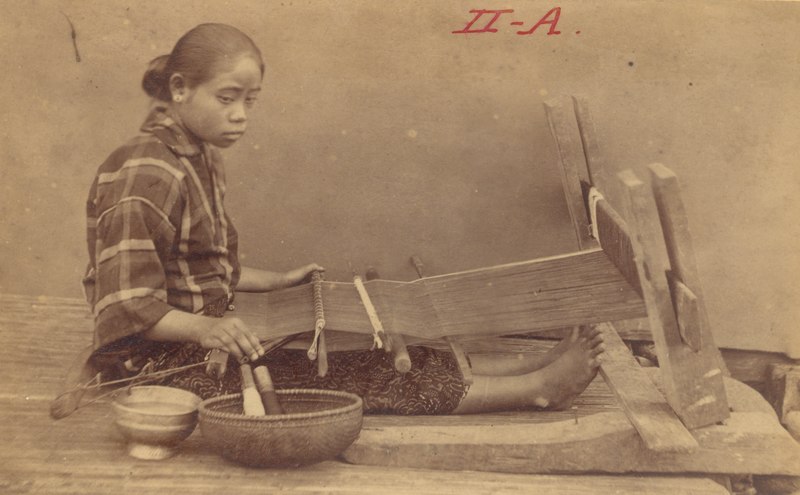
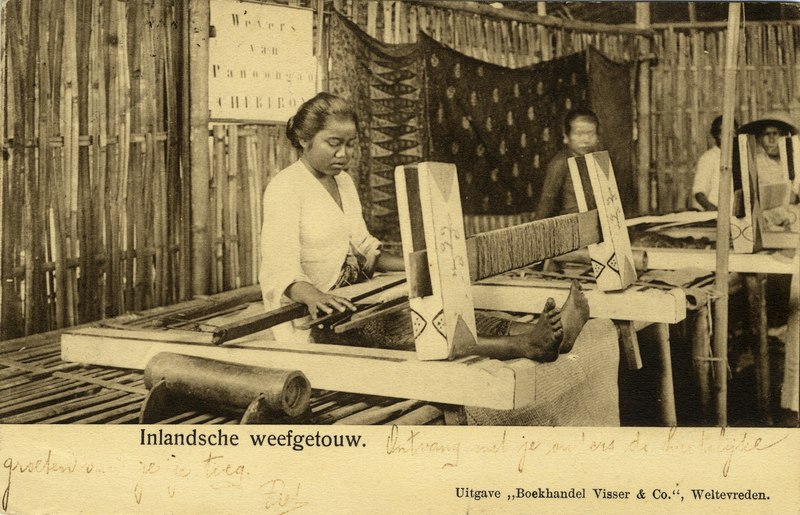


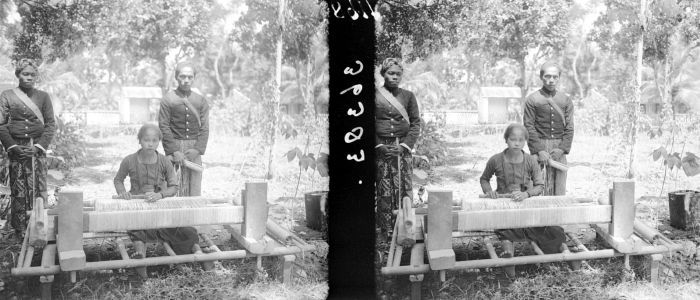


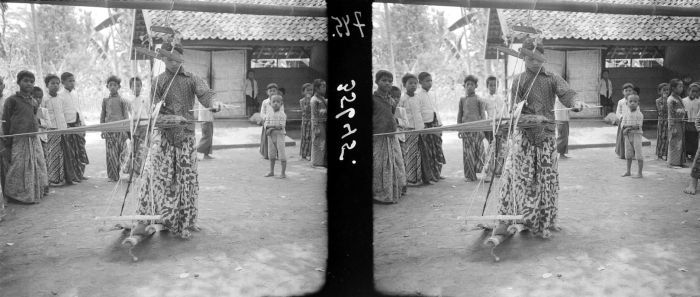
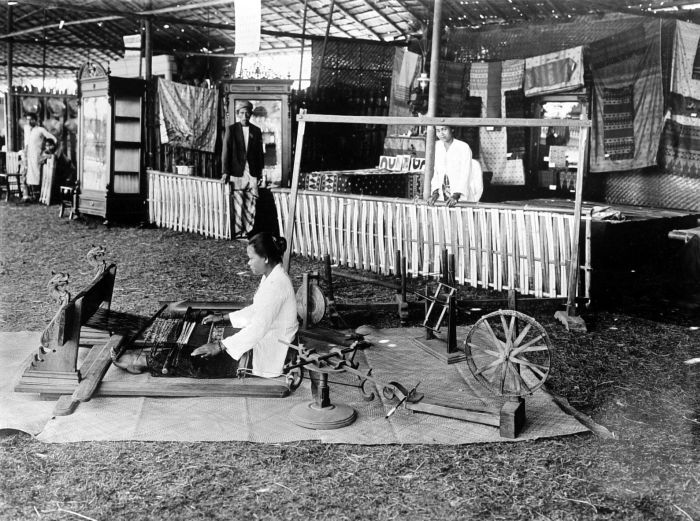



















Write a comment